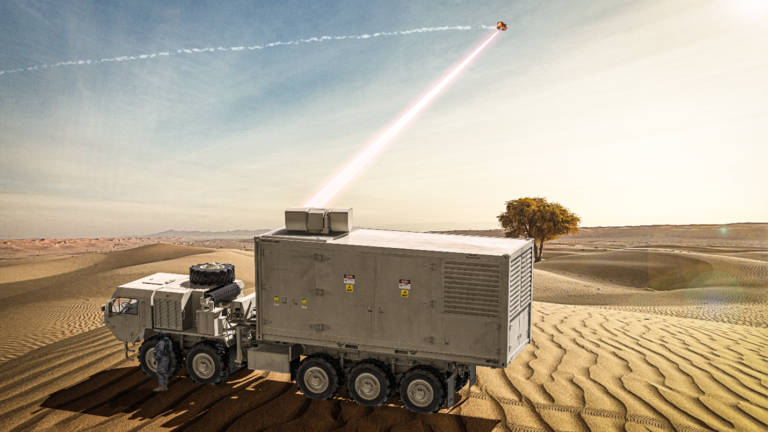
The US Army has given Lockheed Martin a contract to build a high-energy laser prototype for defending stationary and semi-fixed locations against aerial threats as part of their broader goal to advance laser weapon technology.
Advertisement
On July 19, the US Army announced that Lockheed Martin had been granted an “other transaction authority” contract valued at a maximum of $220.8 million.
This contract aims to develop, integrate, manufacture, test, and deliver an Indirect Fire Protection Capability-High Energy Laser (IFPC-HEL) prototype weapon system.
So far, the Army has allocated $154 million from the fiscal 2023 budget to support the project, with the possibility of additional funds being allocated until mid-October 2025.
The information provided does not clarify whether other companies have been selected to build competing prototypes, nor does it specify the details of Lockheed Martin’s deliverables or the specific tests the weapon prototype will undergo.
Advertisement

Lockheed Martin has been working on High Energy Laser (HEL) projects, and one of their notable endeavors includes the development of a 300-kilowatt laser as part of the Pentagon’s High Energy Laser Scaling Initiative (HELSI).
But in March, the Army’s Rapid Capabilities and Critical Technologies Office (RCCTO) called upon the industry to submit white papers proposing lasers in the 100-plus kilowatt class and provide further insights into the program’s objectives.
At the time, the service said that the IFPC-HEL project aims to defend stationary and semi-fixed sites against various threats, including cruise missiles, rockets, artillery, mortars, unmanned aerial systems, and rotary and fixed-wing threats.
The effort involves developing up to four complete HEL weapon systems, comprising the HEL itself, beam control, beam director, battle management, and power and thermal management, all integrated into a government-provided platform.
The delivery of these HEL weapon systems is expected within 20 months after the contract award. Upon successful development, the HEL weapon systems will undergo live fire testing against “operationally relevant targets,” stated the Army.
This testing phase will evaluate the effectiveness and performance of the systems in real-world scenarios to ensure their suitability for operational deployment.
Advertisement
Developing High-Energy Laser Weapons
Laser weapons have garnered widespread interest among military strategists worldwide. The United States has also been actively and ambitiously pursuing developing and utilizing laser weapons capabilities.
In April 2023, the US Government Accountability Office disclosed that the US Department of Defense is investing approximately $1 billion annually in developing “directed energy” weapons.
These advanced weapons include high-energy lasers that effectively neutralize drones in the sky. Recent research efforts have been concentrated on miniaturizing laser weapons to the extent that a single individual can operate them.
Furthermore, the Pentagon is actively exploring the use of high-powered microwave weapons capable of penetrating solid objects and disrupting enemy power sources, sensors, and other electronic systems.
For the US armed services, deploying directed-energy technology could significantly enhance national security.
Advertisement

According to a 2022 analysis conducted by the Congressional Research Service (CRS), an independent agency that provides insights to lawmakers, high-energy lasers and microwave weapons hold considerable potential for short-range air defense, countering drone swarms, and mitigating rocket, artillery, and mortar threats.
The CRS report highlighted that such directed-energy systems, some capable of cutting through steel and aluminum in mere seconds, might offer a more cost-effective and efficient alternative to traditional munitions.
Weapons employing lasers, microwaves, gamma rays, and other electromagnetic energy can be fired repeatedly without mechanical loading, making them more versatile and adaptive in various combat scenarios.
Despite the US lagging in hypersonic weapons, the development of laser weapons is progressing rapidly. All three branches of the US military—the Army, Navy, and Air Force—are actively engaged in high-energy laser weapon projects.
On July 12, 2022, Lockheed Martin delivered LANCE (Laser Advancements for Next-generation Compact Environments), a high-energy laser weapon, to the US Air Force.
Advertisement
After a few months, in August 2022, the US Navy acquired the delivery of a high-energy laser weapon system known as ‘HELIOS’ from Lockheed Martin.
Besides Lockheed Martin, several other prominent American defense manufacturers, such as Raytheon, Northrop Grumman, and Boeing, are also involved in advancing high-energy laser weapons for the US military.
On the other hand, the US adversaries are also integrating Directed Energy Weapons (DEWs), including lasers, into their military arsenals.
Russia has already deployed laser weapons in combat, with the ‘Peresvet’ system showcased by President Putin in 2018, and an advanced laser system, Kalina, under construction at a Russian space facility.
Similarly, Beijing is moving forward with fielding high-energy laser weapons, including claims of equipping the J-20 stealth fighter with DEWs and developing an airborne laser attack pod, as Chinese defense companies like LW-30 demonstrated.